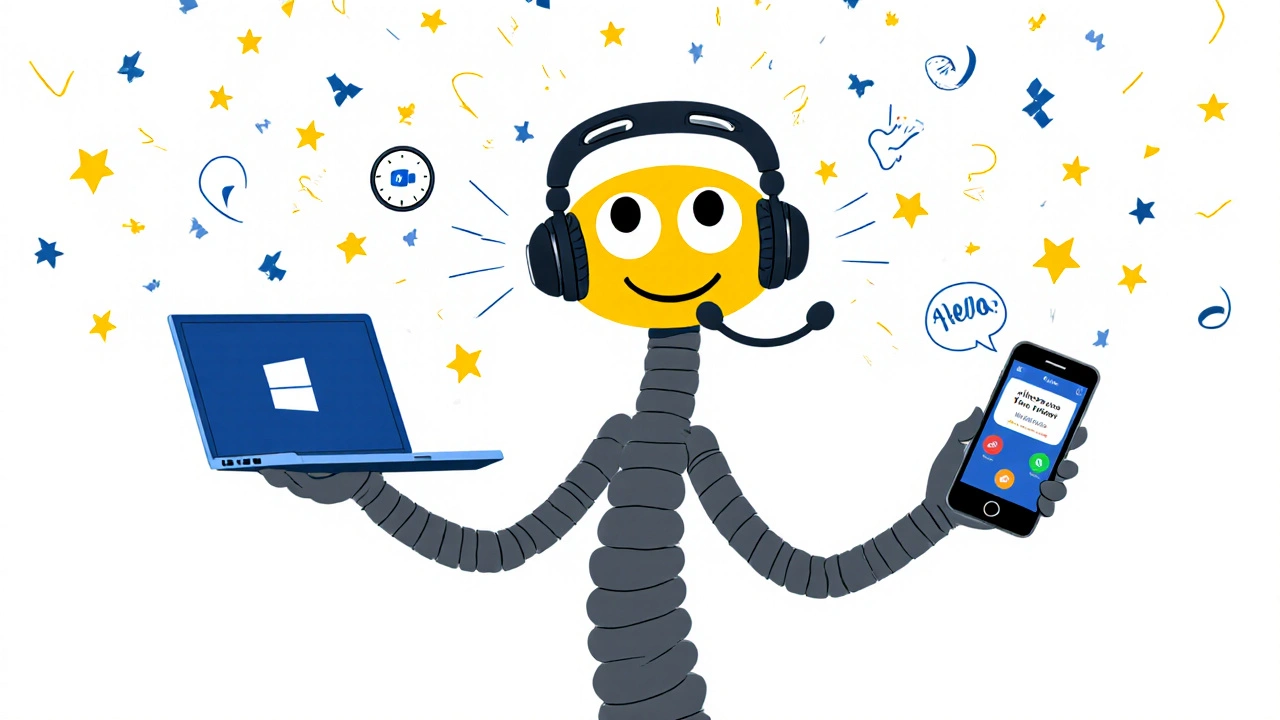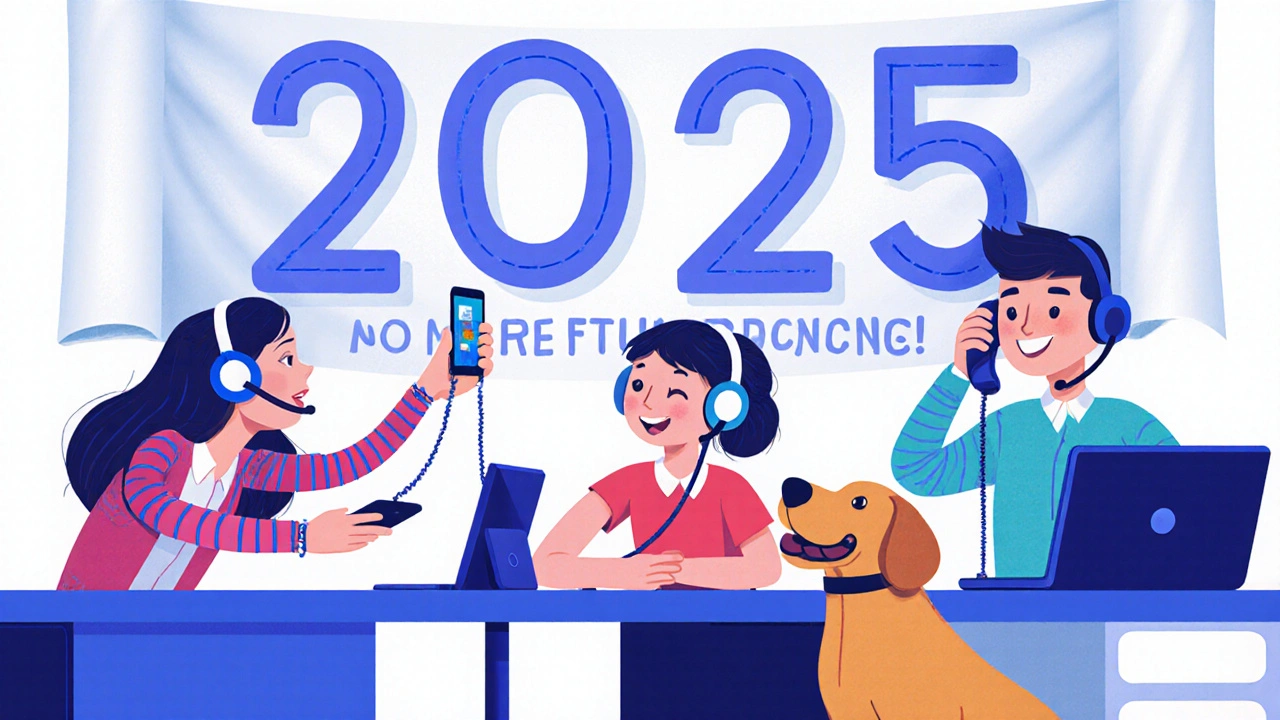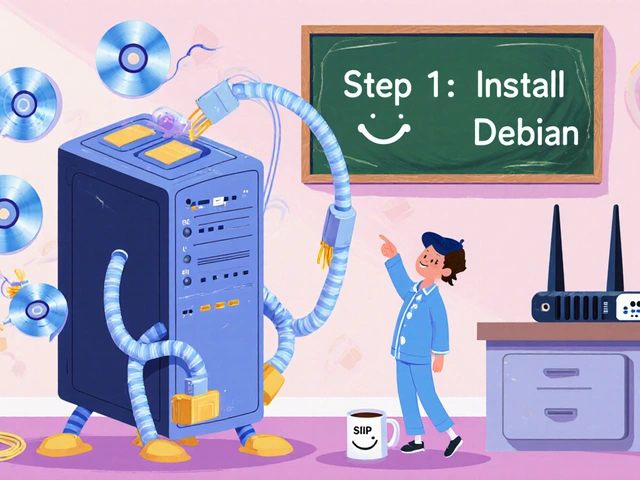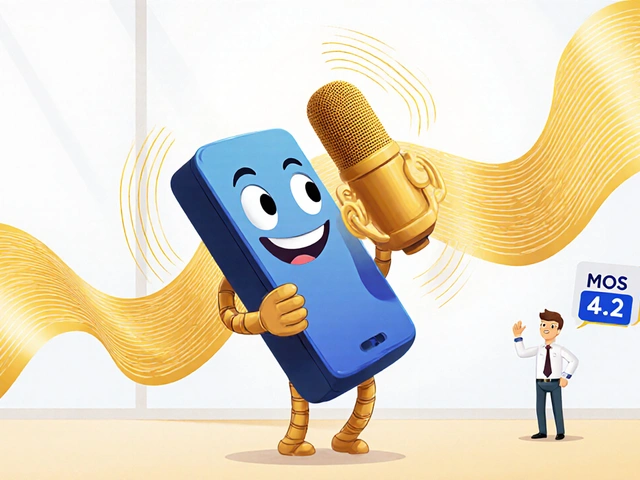Imagine this: you’re on a Zoom call with your team when your phone rings - it’s your client. You fumble to disconnect from your laptop, reach for your phone, reconnect your headset, and by the time you answer, you’ve lost half the conversation. Now imagine doing that five times a day. It’s exhausting. And it’s completely unnecessary.
Bluetooth Multipoint is the quiet fix most people don’t know they need. It lets a single VoIP headset stay connected to two or even three devices at once - your work laptop, your phone, your desk phone - and lets you switch between them without touching a button. No more unplugging, no more re-pairing, no more missed calls because you were mid-switch.
What Bluetooth Multipoint Actually Does
Bluetooth Multipoint isn’t magic. It’s a feature built into the Bluetooth protocol that lets your headset maintain active connections with multiple devices simultaneously. Most headsets only connect to one device at a time. If you get a call on your phone while on a Teams meeting, you have to manually disconnect from your laptop, then reconnect to your phone. That’s a 5- to 10-second delay - and in a fast-paced work environment, that’s enough time to lose your train of thought, miss an important detail, or make the caller wait too long.
Multipoint changes that. With it, your headset stays connected to both your laptop and your phone. When a call comes in on your phone, your headset alerts you. You press a button, and the call transfers instantly. The Teams call goes on hold. No disconnect. No re-pairing. No fumbling.
This isn’t a luxury feature anymore. It’s a productivity baseline. According to Gartner, teams using multipoint headsets saw a 23% drop in communication interruptions in 2023. That’s not a small gain. It’s hours saved every week.
How It Works: Profiles, Versions, and Latency
Bluetooth Multipoint doesn’t work on its own. It needs the right profiles and versions to function properly. Your headset must support the Hands-Free Profile (HFP) or Headset Profile (HSP) for voice calls, and the Advanced Audio Distribution Profile (A2DP) for music or media. Most modern headsets have this, but older or budget models might not.
Bluetooth version matters too. Bluetooth 4.0 introduced multipoint, but it was clunky. Bluetooth 5.0 and above - especially 5.2 and 5.3 - handle connections more reliably. If you’re using a 2018 headset with a 2025 laptop, you might get inconsistent results. Stick with devices that are Bluetooth 5.0 or newer for the smoothest experience.
Latency? Yes, there’s a tiny delay - about 15 to 25 milliseconds - when switching between devices. But that’s less than the blink of an eye. Humans start noticing audio lag at 100ms. You won’t feel it.
Battery life? You’ll lose about 15-20% compared to a single-point headset. But if you’re switching devices constantly anyway, you’re probably draining your battery faster by reconnecting. Multipoint is more efficient in real-world use.
The Three Types of Multipoint: Simple, Advanced, Triple
Not all multipoint is the same. There are three levels, and knowing the difference can save you from buying the wrong headset.
- Simple Multipoint: Connects to two devices, but if a second call comes in, it drops the first. You’re forced to manually go back to the original call. This is the cheapest version - found in about 65% of multipoint headsets. It’s better than nothing, but it’s not seamless.
- Advanced Multipoint: The gold standard. Keeps both calls active. When a second call comes in, it puts the first on hold. You can switch back and forth with a single button press. This is what professionals use. Around 30% of business headsets have this, and it’s becoming the new norm. Jabra, Bose, and Yealink lead here. Switching time? From 8.2 seconds down to 0.8 seconds.
- Triple Connectivity: Connects to three devices. Usually your laptop, phone, and a desk phone via a base station. Only 5% of headsets offer this. Mostly found in premium models like the Yealink UH33. Useful for call center agents or people who juggle three communication channels daily.
For most people, Advanced Multipoint is the sweet spot. You’re not paying extra for a third device you don’t need. You’re paying for the ability to hold one call while answering another - which is exactly what hybrid work demands.

Real-World Use Cases: Who Needs This Most?
Let’s say you’re a customer service rep using Microsoft Teams for internal chats and Zoom for client calls. Your phone rings with a personal emergency. With a single-point headset, you hang up your Teams call, answer your phone, then reconnect to Teams. You lose context. You lose time. You lose trust.
With Advanced Multipoint, you press the button. The Teams call pauses. You answer your phone. You talk. You hang up. You press the button again. Teams resumes. No interruption. No apology needed.
Or you’re a manager with a work laptop and a personal phone. You’re in a Teams meeting when your kid’s school calls. You don’t have to leave the meeting. You don’t have to explain why you’re on mute. You just answer. Then go back. Clean. Professional. Stress-free.
Even freelancers benefit. You’re on a Zoom call with a client, and your Upwork notification pings with a quick question. You switch to your phone, answer in 30 seconds, and return - without ever breaking the client’s flow.
Setting It Up: What Actually Happens?
Setup isn’t rocket science, but it’s not always intuitive either. Here’s the standard process:
- Turn on your headset in pairing mode.
- Pair it with your primary device - usually your laptop or desktop. This is your main work device.
- Turn off Bluetooth on your headset (or disconnect manually).
- Pair it with your second device - your phone.
- Turn the headset off and on again.
- It should reconnect to both devices automatically.
That’s it. Most headsets remember both connections. The next time you power on, they reconnect without input.
Pro tip: Use the manufacturer’s app. Jabra’s Sound+ app, Bose’s app, and Yealink’s tools let you check connection status, update firmware, and even set up call prioritization based on your calendar. If your headset has an app - use it.
Common setup problems? Older Windows PCs with outdated Bluetooth drivers. Android phones that don’t support HFP properly. Macs that forget connections after updates. The fix? Update your OS. Update your Bluetooth drivers. If your laptop is from 2017 or earlier, it might not support multipoint well - consider a USB Bluetooth adapter.
Which Headsets Actually Do It Right?
Not all brands implement multipoint the same way. Some are smooth. Others are glitchy. Here’s what’s working in 2025:
- Jabra Evolve2 85: The most reliable Advanced Multipoint headset on the market. Seamless switching, excellent noise cancellation, and calendar integration that auto-pauses meetings when you answer a call.
- Bose QuietComfort Ultra: Great sound, solid multipoint, but slightly higher latency on Android. Best for Apple users.
- Yealink UH33: Triple connectivity. Ideal for call centers. Works with desk phone docks. Expensive, but worth it if you need three lines.
- Shokz OpenRun Pro: Bone conduction, so you hear your surroundings. Supports multipoint. Great for people who need to stay aware of their environment - like remote workers with kids at home.
- Logitech Zone Wireless: Solid mid-range option. Good for Teams and Zoom. No triple connectivity, but Advanced Multipoint works flawlessly.
Avoid budget brands like TaoTronics or Anker for business use. Their multipoint implementations are hit-or-miss. You’ll spend more time troubleshooting than saving time.

The Downsides: What No One Tells You
It’s not perfect. Here are the real complaints from users:
- Setup confusion: 32% of negative Amazon reviews cite “confusing pairing.” It’s not the feature - it’s the instructions. Stick to brands with clear guides (Jabra and Poly score 4.7/5).
- OS inconsistencies: 27% of hybrid Mac/Windows users report audio dropouts when switching between systems. Firmware updates fix most of this.
- Battery life: You’ll need to charge more often. But if you’re using your headset all day, you were going to charge it anyway.
- Overhyped by marketers: Some users say they could just use notification settings or separate headsets. But if you’ve ever had to explain to a client why you were on mute for 45 seconds, you know - multipoint isn’t a gimmick. It’s a necessity.
Why This Matters in 2025
The global business headset market hit $2.8 billion in 2022. Of that, 63% were multipoint models - up from 29% in 2019. By 2025, IDC predicts 92% of business headsets will include multipoint. It’s not coming. It’s already here.
Companies like Cisco and HP are rolling out multipoint headsets to 80% of their remote teams. Why? Because the cost of lost time adds up. A 23% reduction in interruptions means more focused work, fewer missed calls, and better client relationships.
And with Bluetooth LE Audio and the LC3 codec rolling out in 2024-2025, future headsets will support more devices, longer battery life, and better sound - all at the same time. The next generation will make today’s models look clunky.
Should You Get One?
If you use your headset for more than one device - and you’re not just listening to music - then yes. If you’re on calls with clients, coworkers, or family across different platforms, you’re wasting time every day. That time adds up to hours per week. Hours per month. Days per year.
Advanced Multipoint headsets cost $150-$250. That’s less than a month’s coffee habit. The ROI? Clearer communication, fewer interruptions, and less stress. You’re not just buying a headset. You’re buying back your focus.
Don’t wait for your company to upgrade you. If you’re working remotely, this is a tool that belongs in your kit - like a good keyboard or a second monitor. It’s not fancy. It’s functional. And it works.
Can I use Bluetooth Multipoint with my iPhone and Windows laptop at the same time?
Yes, as long as both devices support Bluetooth 4.0 or higher and your headset supports Advanced Multipoint. iPhones handle multipoint well with iOS 14+, and Windows 10/11 with updated Bluetooth drivers work reliably. Avoid older Windows PCs with outdated hardware - they often drop connections.
Does Bluetooth Multipoint work with Zoom, Teams, and Google Meet?
Yes. Multipoint works at the Bluetooth level, not the app level. So whether you’re on Zoom, Teams, or Google Meet, as long as your headset is connected to your laptop, the call audio will route through it. You can switch to your phone call without affecting the meeting - it just pauses.
Why does my headset drop one connection when I switch devices?
You likely have a Simple Multipoint headset, not Advanced. Simple Multipoint drops the first call when a second comes in. To fix this, check your headset model. If it’s not listed as Advanced Multipoint, you’ll need to upgrade. Look for models from Jabra, Bose, or Yealink that specifically mention "hold one call while answering another."
Do I need to buy a new headset if mine is from 2020?
It depends. If your 2020 headset supports Bluetooth 5.0+ and has Advanced Multipoint, it’s still fine. But if it’s an older model (Bluetooth 4.0 or lower) or only has Simple Multipoint, you’re missing out on seamless switching. Newer models have better firmware, battery life, and app integration. Consider upgrading if you’re frustrated with switching delays.
Can I connect three devices at once?
Only with triple connectivity models - and they’re rare. The Yealink UH33 and Jabra Evolve2 85 (with a dock) support three devices. Most headsets only do two. If you need three, you’re likely in a call center or enterprise role. For most people, two is enough.
Is Bluetooth Multipoint better than having two separate headsets?
Yes, because you don’t have to swap gear. Two headsets mean two batteries to charge, two sets of earpieces to manage, and two devices to keep track of. With multipoint, you have one headset, one button, one cable. It’s simpler, cleaner, and less cluttered. Plus, you avoid the awkward moment of grabbing the wrong headset mid-call.










Wilda Mcgee
30 Oct 2025 at 21:14Okay but real talk - I didn’t even know this was a thing until my boss handed me a Jabra Evolve2 85 and said ‘stop being a mess’
I used to have three different headsets lying around - one for Zoom, one for calls, one for music (yes I’m that person)
Now I just press one button and my kid’s school call interrupts my client meeting like it’s supposed to - no panic, no fumbling, no ‘hold on let me switch’
It’s not magic, it’s just smart design
And honestly? My stress levels dropped 40%. I didn’t realize how much mental energy I was wasting just managing audio
Also - use the Jabra app. It auto-pauses meetings when your phone rings. I cried the first time it happened. I was not ready for that level of grace